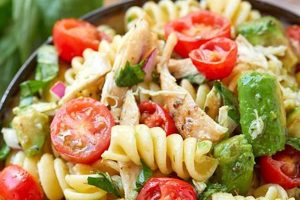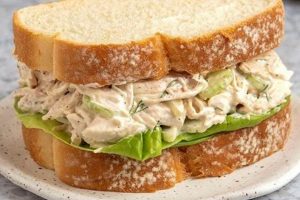This classic dish combines tender chicken, perfectly cooked potatoes, and a creamy, flavorful dressing. Variations often include celery, onions, and hard-boiled eggs, contributing to a rich textural experience. A well-executed version balances the savory elements of the chicken with the tangy dressing and the satisfying heartiness of the potatoes.
This comfort food staple holds a prominent place in American cuisine, frequently appearing at picnics, potlucks, and family gatherings. Its versatility makes it an ideal side dish or a light main course. The dish offers a convenient and satisfying way to incorporate protein and vegetables into a meal. Its enduring popularity stems from its simple preparation, affordability, and delicious flavor profile, appealing to a broad audience across generations.
This exploration will delve into variations on the traditional preparation, offering insights into ingredient selection, cooking techniques, and optimal flavor combinations. Whether seeking a classic recipe or exploring creative adaptations, readers will find valuable guidance for crafting a memorable culinary experience.
Tips for a Superior Potato Salad
Elevating this classic dish involves attention to detail and a focus on quality ingredients. The following tips offer guidance for achieving optimal flavor and texture.
Tip 1: Potato Selection Matters: Opt for waxy potatoes like Yukon Gold or red potatoes. These varieties hold their shape well during cooking and offer a creamy texture, avoiding a mushy result.
Tip 2: Precise Cooking Techniques: Cook potatoes until tender but not overcooked. Start in cold, salted water to ensure even cooking. Avoid boiling vigorously, which can cause the potatoes to break apart.
Tip 3: Enhancements through Seasoning: Incorporate seasonings while the potatoes are still warm to maximize absorption. Consider adding herbs, spices, or a touch of vinegar for depth of flavor.
Tip 4: Chicken Preparation is Key: Use high-quality, cooked chicken. Rotisserie chicken offers a convenient and flavorful option. Ensure the chicken is shredded or diced into bite-sized pieces.
Tip 5: The Art of the Dressing: The dressing binds the ingredients and contributes significantly to the overall flavor profile. Achieve a balance of creamy, tangy, and savory elements. Freshly made mayonnaise is often preferred.
Tip 6: The Role of Complementary Ingredients: Additions like celery, onions, and hard-boiled eggs provide textural contrast and enhance the flavor complexity. Consider incorporating finely diced pickles or relish for a tangy twist.
Tip 7: Chilling for Optimal Flavor: Allow the salad to chill thoroughly before serving. This allows the flavors to meld and the textures to settle, resulting in a more harmonious final product.
By adhering to these guidelines, one can create a potato salad that stands out for its balanced flavors, pleasing textures, and overall appeal.
From ingredient selection to chilling techniques, careful attention to detail ensures a truly exceptional culinary experience.
1. High-Quality Chicken
High-quality chicken significantly impacts the overall quality of this potato salad. Chicken contributes a substantial protein element and influences the flavor profile. Selecting superior chicken ensures a pleasant, savory taste that complements the other ingredients without introducing off-flavors. Tender, flavorful chicken elevates the dish beyond a simple side to a more substantial and satisfying meal. For instance, using freshly roasted or grilled chicken, as opposed to pre-packaged, processed options, noticeably enhances the taste and texture, creating a more appealing final product. Employing inferior chicken, however, can result in a dry, stringy, or bland salad, diminishing the overall culinary experience.
The choice of chicken influences not only the flavor but also the perceived freshness and quality of the entire dish. Consumers readily discern the difference between fresh, flavorful chicken and bland, processed alternatives. This distinction directly impacts satisfaction and enjoyment. Consider the difference between using leftover roasted chicken from a quality butcher versus using pre-cooked, diced chicken from a mass-produced package. The former imbues the salad with a richer, more authentic flavor, while the latter may introduce unwanted preservatives or additives, detracting from the natural flavors of the other ingredients. Furthermore, the texture of the chicken matters. Dry, overcooked chicken will negatively impact the overall texture of the salad.
Prioritizing high-quality chicken demonstrates an investment in the final product. This commitment to quality ingredients resonates with consumers, reflecting an attention to detail that elevates the entire dining experience. Understanding the impact of chicken quality allows one to make informed decisions, ensuring a delicious and satisfying potato salad. Ultimately, selecting appropriate chicken significantly contributes to achieving a well-balanced, flavorful, and texturally pleasing result. This reinforces the importance of ingredient selection in achieving culinary excellence, demonstrating that even seemingly simple dishes benefit from careful consideration of components.
2. Properly Cooked Potatoes
Properly cooked potatoes are fundamental to a successful potato salad. Undercooked potatoes result in an unpleasant, starchy texture, while overcooked potatoes become mushy and disintegrate when mixed with other ingredients. The ideal texture is firm enough to hold its shape yet tender enough to be easily pierced with a fork. This balance ensures the potatoes contribute a pleasant textural element to the salad without becoming overly dominant or dissolving into the dressing. Consider the difference between a salad with firm, distinct potato pieces and one where the potatoes have become a starchy paste. The former provides a satisfying chewiness that complements the other ingredients, while the latter creates an unappetizing, gluey consistency.
Achieving properly cooked potatoes requires careful attention to the cooking process. Starting with cold, salted water and bringing the potatoes to a gentle boil ensures even cooking throughout. Boiling too vigorously can cause the outsides of the potatoes to cook faster than the insides, leading to uneven texture. Regularly testing the potatoes for doneness with a fork or knife helps to prevent overcooking. Once tender, the potatoes should be drained immediately and allowed to cool completely before being incorporated into the salad. This prevents further cooking from residual heat and maintains the desired texture. Overlooking these seemingly minor details can significantly impact the overall quality and enjoyment of the final dish.
The significance of properly cooked potatoes extends beyond mere texture. Well-cooked potatoes absorb the flavors of the dressing and other ingredients more effectively, contributing to a more cohesive and flavorful salad. Conversely, improperly cooked potatoes can act as a barrier, preventing flavor penetration and resulting in a bland, disjointed final product. One can envision the difference between a salad where the potatoes are infused with the tangy dressing and savory chicken flavors versus one where the potatoes remain a separate, starchy entity. The former presents a harmonious blend of flavors, while the latter offers a fragmented and less satisfying experience. Thus, properly cooked potatoes serve as a critical foundation upon which a truly delicious and well-balanced potato salad is built.
3. Balanced, flavorful dressing
A balanced, flavorful dressing is paramount in distinguishing a truly exceptional potato salad from a mediocre one. The dressing serves as the unifying element, binding the individual componentspotatoes, chicken, and other ingredientsinto a cohesive whole. It provides the dominant flavor profile, influencing the overall taste experience significantly. An unbalanced dressing can overwhelm the other ingredients, rendering the chicken bland and the potatoes merely a vehicle for the sauce. Conversely, a bland dressing fails to elevate the dish, leaving it tasting flat and uninspired. Consider a dressing overly reliant on sweetness; it might mask the savory notes of the chicken and the subtle earthiness of the potatoes. In contrast, a dressing lacking acidity can result in a heavy, cloying salad that lacks brightness and freshness.
The concept of balance within the dressing refers to the harmonious interplay of different flavor elements: tanginess, sweetness, creaminess, and savory notes. Achieving this balance requires careful consideration of ingredient ratios and flavor pairings. For instance, the tanginess of vinegar or mustard should be balanced by the sweetness of sugar or relish, while the richness of mayonnaise should be offset by the brightness of fresh herbs or spices. The specific balance will vary depending on individual preferences and the overall flavor profile desired, ranging from classic creamy dressings to lighter, vinaigrette-based options. A successful dressing complements, rather than overpowers, the other ingredients, allowing their individual flavors to shine through while contributing to the overall harmony of the dish. Imagine a dressing where the tang of Dijon mustard perfectly complements the richness of the mayonnaise, creating a nuanced flavor profile that enhances the taste of the chicken and potatoes without masking their individual characteristics.
Mastering the art of a balanced, flavorful dressing is crucial for elevating potato salad to a culinary experience. It transforms a simple combination of ingredients into a dish that is both satisfying and memorable. The interplay of flavors within the dressing contributes significantly to the overall enjoyment and appreciation of the salad. Challenges may arise in achieving the ideal balance, requiring experimentation and adjustments based on individual tastes and the specific ingredients used. However, understanding the importance of this balance allows for informed decision-making in crafting a dressing that complements and enhances the other components, resulting in a truly exceptional potato salad. This understanding highlights the significance of seemingly minor details in culinary endeavors, showcasing how the careful consideration of a single element can dramatically impact the final product.
4. Complementary Ingredients
Complementary ingredients in a potato salad contribute significantly to its overall flavor profile, texture, and visual appeal. They transform a simple combination of potatoes and dressing into a complex and satisfying dish. Consideration of these additions is crucial in achieving a well-balanced and enjoyable potato salad experience, particularly when aiming to replicate or enhance a specific recipe variation.
- Textural Contrast
Ingredients like celery, onion, and hard-boiled eggs introduce textural variety, contrasting with the softness of the potatoes and creaminess of the dressing. Crisp celery offers a refreshing crunch, while finely diced red onion provides a sharp bite. The inclusion of hard-boiled eggs contributes a creamy, protein-rich element that contrasts with the other textures. These elements prevent the salad from becoming monotonous and provide a more dynamic eating experience.
- Flavor Enhancement
Complementary ingredients introduce layers of flavor that enhance the overall taste profile. Fresh herbs like dill or parsley provide a bright, herbaceous note, while spices like paprika or mustard powder add depth and complexity. Pickles or relish introduce a tangy, acidic element that balances the richness of the mayonnaise-based dressing. These additions create a more nuanced and interesting flavor profile, moving beyond the basic flavors of potato and dressing.
- Visual Appeal
The strategic use of complementary ingredients enhances the visual appeal of the potato salad. Brightly colored ingredients like red onion, bell peppers, or chopped chives add visual interest to the creamy base of the salad. The careful arrangement of these elements can create a visually appealing dish that is more enticing to the eye. Garnishing with fresh herbs or a sprinkle of paprika adds a final touch that elevates the presentation.
- Regional Variations
Complementary ingredients often reflect regional culinary traditions and preferences. In some regions, the addition of bacon or ham is common, adding a smoky, savory element. Other regions might favor the inclusion of olives, capers, or other ingredients that reflect local tastes and ingredient availability. These variations provide a glimpse into culinary traditions and demonstrate the adaptability of this classic dish.
The careful selection and incorporation of complementary ingredients elevate potato salad from a simple side dish to a more complex and satisfying culinary creation. These additions contribute not only to flavor and texture but also to visual appeal and regional variations, highlighting the versatility and adaptability of this classic dish. Understanding the role of complementary ingredients allows for informed choices that enhance the overall enjoyment of potato salad. This emphasizes the importance of considering all elements of a dish, even those seemingly secondary, in creating a truly exceptional culinary experience.
5. Precise Seasoning
Precise seasoning distinguishes an exceptional potato salad from an ordinary one, particularly within the context of a specific recipe variation like Chicken Annie’s. Seasoning elevates the inherent flavors of the core ingredientspotatoes, chicken, and dressingwithout masking their individual characteristics. It provides depth and complexity, transforming a simple combination of ingredients into a harmonious and flavorful dish. The balance of salt, pepper, and other spices is crucial. Too much salt can overpower the other flavors, while too little can leave the salad tasting bland. The correct balance enhances the natural sweetness of the potatoes and the savory notes of the chicken, creating a well-rounded flavor profile. Consider the impact of freshly ground black pepper; the right amount adds a subtle warmth and complexity without overwhelming the other spices.
Achieving precise seasoning requires careful consideration of the other ingredients and their individual flavor profiles. The inherent saltiness of certain ingredients, such as pickles or olives, must be taken into account when determining the overall salt level. Similarly, the use of spices within the dressing requires careful balancing within the overall seasoning strategy. For example, if the dressing incorporates paprika or mustard powder, the overall seasoning might require less of these spices to avoid an overpowering taste. Furthermore, the timing of seasoning plays a crucial role. Seasoning the potatoes while they are still warm allows for better absorption of flavor, ensuring that the seasoning is evenly distributed throughout the salad. Imagine the difference between potatoes seasoned while warm, allowing the salt and spices to penetrate deeply, versus potatoes seasoned after cooling, where the seasoning remains primarily on the surface.
Mastery of precise seasoning demonstrates an attention to detail that elevates the entire culinary experience. It reflects an understanding of the interplay of flavors and the importance of balance in creating a truly exceptional dish. While replicating a specific recipe might provide a starting point, understanding the underlying principles of seasoning allows for adaptation and personalization based on individual preferences and ingredient variations. This nuanced approach to seasoning distinguishes a thoughtfully prepared potato salad from a hastily assembled one, highlighting the crucial role of precise seasoning in achieving culinary excellence. This emphasizes the transformative power of seemingly small adjustments in achieving a superior culinary outcome, reinforcing the importance of precision and balance in cooking.
6. Sufficient Chilling Time
Sufficient chilling time is crucial for achieving the desired flavor and texture in a potato salad, especially when considering variations like Chicken Annie’s. Chilling allows the flavors of the various componentspotatoes, chicken, dressing, and other ingredientsto meld and harmonize, resulting in a more cohesive and complex flavor profile. Furthermore, chilling firms the potatoes and allows the dressing to thicken, contributing to a more desirable texture.
- Flavor Development
Chilling allows the diverse flavors within the potato salad to meld and mature. The potatoes absorb the flavors of the dressing, the chicken contributes its savory notes, and the complementary ingredients release their aromatic compounds. This fusion of flavors creates a more nuanced and balanced taste experience compared to a freshly made salad. This melding is particularly important in variations like Chicken Annie’s, where the interplay of spices and other ingredients benefits from sufficient chilling time.
- Texture Enhancement
Chilling firms the potatoes, preventing them from becoming mushy and improving the overall texture of the salad. The dressing also benefits from chilling, as it thickens and becomes more cohesive, binding the ingredients together more effectively. This textural improvement contributes to a more pleasant eating experience, offering a balance of creamy dressing, firm potatoes, and other textural elements from complementary ingredients.
- Food Safety
From a food safety perspective, sufficient chilling time is essential, especially for salads containing mayonnaise-based dressings and cooked chicken. Chilling inhibits bacterial growth and reduces the risk of foodborne illness. Maintaining the salad at a safe temperature below 40F (4C) is crucial for preserving its quality and ensuring it remains safe for consumption.
- Serving Temperature
Serving potato salad chilled enhances its refreshing qualities, making it particularly appealing in warmer weather or as a complement to heavier dishes. The cool temperature provides a pleasant contrast to other elements of a meal and contributes to a more enjoyable dining experience. This is especially relevant for outdoor gatherings and picnics, where Chicken Annie’s potato salad might be served.
Therefore, sufficient chilling time is not merely a final step but a crucial element in achieving a well-balanced, flavorful, and safe potato salad. It allows for flavor development, texture enhancement, and adherence to food safety guidelines, contributing significantly to the overall enjoyment of the dish. Understanding the importance of this final stage, particularly in relation to specific recipe variations like Chicken Annie’s, allows for a more informed and deliberate approach to preparation, ultimately resulting in a superior culinary outcome.
Frequently Asked Questions
This section addresses common inquiries regarding the preparation and variations of this classic dish.
Question 1: What type of potato is best suited for this potato salad?
Waxy potatoes, such as Yukon Gold or red potatoes, are recommended. These varieties hold their shape well during cooking and offer a creamy texture, avoiding a mushy result. Russet potatoes, while commonly used for baking, tend to fall apart in potato salad.
Question 2: Can the dressing be made in advance?
The dressing can be prepared a day in advance and stored in the refrigerator. This allows the flavors to meld and intensify. However, it’s generally recommended to add the dressing to the potatoes and other ingredients shortly before serving to prevent the potatoes from becoming overly saturated.
Question 3: What can be substituted for mayonnaise in the dressing?
Plain Greek yogurt or a combination of yogurt and mayonnaise offer a lighter alternative to traditional mayonnaise-based dressings. These substitutions reduce the overall fat content while maintaining a creamy texture. Alternatively, a vinaigrette-based dressing can be used for a tangier, less creamy option.
Question 4: How long should the salad be chilled before serving?
Chilling for at least two hours allows the flavors to meld and the potatoes to firm up. Optimal chilling time is four to six hours, or even overnight, for maximum flavor development and texture enhancement.
Question 5: How long can potato salad be stored in the refrigerator?
Properly stored in an airtight container, potato salad can be refrigerated for up to three days. However, it’s crucial to monitor for any signs of spoilage, such as off-odors or changes in texture, and discard if any concerns arise.
Question 6: Can this recipe be adapted for different dietary needs?
This dish is highly adaptable. For gluten-free versions, ensure all ingredients, including seasonings and condiments, are gluten-free. Vegan variations can utilize plant-based mayonnaise and omit the chicken and eggs, substituting chickpeas or other legumes for added protein.
Careful attention to these frequently asked questions ensures a successful outcome when preparing potato salad. Understanding ingredient selection, preparation methods, and storage guidelines allows for informed decision-making and facilitates culinary success.
This concludes the frequently asked questions section. The next section offers further insights and variations on this classic dish.
Chicken Annie’s Potato Salad Recipe
This exploration has provided a comprehensive overview of the elements contributing to a successful rendition of this classic dish. From the selection of high-quality chicken and proper potato preparation to the nuances of a balanced dressing and the strategic incorporation of complementary ingredients, each component plays a crucial role in the final outcome. Precise seasoning and sufficient chilling time further enhance the flavor profile and textural experience, demonstrating that attention to detail elevates this seemingly simple dish to a culinary achievement. Addressing frequently asked questions provides practical guidance for navigating common challenges and adapting the recipe to individual preferences and dietary needs.
Ultimately, achieving a truly exceptional potato salad requires not merely following a recipe but understanding the underlying principles that govern flavor, texture, and balance. This knowledge empowers culinary exploration, allowing for personalized variations while preserving the essence of this beloved dish. Continued experimentation and refinement of technique will undoubtedly lead to further appreciation of the subtle nuances that distinguish a truly memorable potato salad experience.






